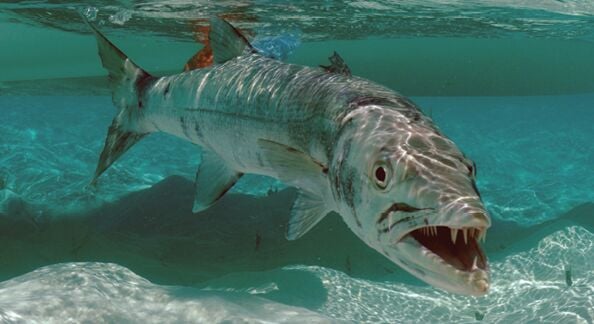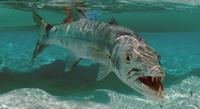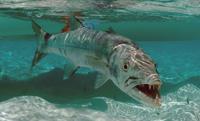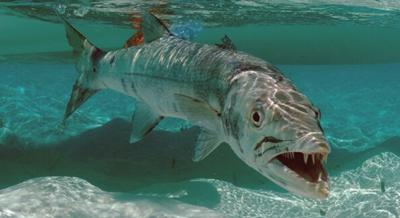Merciless! That is the word I would use to best describe the most voracious predator inhabiting Florida waters—the great barracuda. While these unpredictable fish may exhibit docile tendencies, don’t be fooled. This underappreciated sport fish trumps nearly all others in its intimidating appearance, ferocious hunting skills and violent temperament.
messenger1

messenger1
Image 1 of 9
Rarely targeted with enthusiasm, big barracuda are worthy opponents on the appropriate tackle and often add a level of excitement to an otherwise slow day.
With exposed fangs that resemble some sort of prehistoric creature, great barracuda are feared for their large size and zombie-like state as they rest motionless in preparation of their next kill. Mature specimens as long as a man is tall, appear as if they were reborn from the dead, and have evolved into perfect killing machines designed for the sole purpose of slaughtering prey with no mercy. While it may sound gruesome, the voracious jaws of a barracuda are truly the stuff nightmares are made of.
The great barracuda is a specialized aquatic assassin. Depending on the habitat, ’cuda can feature dark blue or olive color along its upper flanks, with reflective sides and a chalky-white undercarriage. In many cases, irregular black spots or a row of dark bars develop on each side. Combine that with a streamlined frame and the barracuda’s appearance is unmistakable. Yet this slender and silent killer doesn’t rely on a sleek disguise to conceal its presence.
Unlike snook and other shallow water ambush predators that hide in the shadows and wait for an unsuspecting meal to wander too close, great barracuda aren’t afraid to stalk their prey in plain sight. This confident carnivore methodically tracks its next casualty with the calmness of a monk, only exploding in a rage of fury at the very last moment to snatch and eviscerate the unfortunate meal. With blistering speed and bone crushing power, death is inevitable.
Unique to the species, great barracuda are equally at home hovering over a jagged wreck or reef under two hundred feet of water as they are cruising a pristine flat in less than two feet of water. They also inhabit residential canals, open bays, secluded shorelines and every body of water in between. And while rarely targeted beyond the reef with any sort of enthusiasm, it’s in the shallow backcountry and on the flats where one can truly appreciate the great barracuda’s impressive sporting qualities.
Thanks to an expansive range spanning tropical seas worldwide, and the ability to acclimate to a broad range of salinity levels, water clarity and temperature fluctuations, the great barracuda may rear its ugly face just about anywhere on any given day, and may just be the most adaptable game fish of all time. While sometimes frowned upon, great barracuda are certainly a worthy adversary deserving of much more recognition than what they currently receive. Even the mere presence of barracuda has underlying benefits, often signaling fertile waters and optimal feeding scenarios. Out on the flats, this malicious murderer may just be stalking the same fish you are.
While local anglers may bypass a dozen ’cuda for a single shot at a laid up ’poon, visiting anglers from far and wide would jump at the opportunity to tangle with one of the ocean’s premier predators—a wild animal with a wicked set of razor-sharp teeth—and their chances of connecting are solid.
Barracuda are opportunistic feeders with keen eyesight and will not hesitate staring down and consuming whatever available prey is present in its surrounding habitat. As far as these voracious feeders are concerned, if it has fins and swims it qualifies as food.
With a lifespan stretching 10- to 15-years, prize-fighting ‘cuda are capable of killing prey equal to their own size. They are masters that employ a ram strike feeding trait, quickly lunging to force and trap prey in their jaws, where sharp teeth and aggressive headshakes tear large pieces of flesh. These fish leave nothing in their wake but a gruesome blood bath, and it’s this same ferocity that makes the great barracuda such an exciting game fish.
On the tropical flats across the Florida Keys and The Bahamas, and throughout the Sunshine State’s fertile backcountry venues, the occasional barracuda appear to pop up out of nowhere, and it’s the opportunistic angler who is rigged and ready for the encounter that often ends up with an exciting experience to add to his or her day. While fish in the 10- to 20-pound range are most common in the shallows, don’t be surprised to cross paths with a serious log.
If you are handy with a fly rod, a 10-weight with plenty of backing, floating line and wire leader is enough to subdue even the largest specimen. Brightly colored large profile streamers, baitfish patterns and poppers work, just strip it FAST! Pink and green are proven colors, yet just about anything bright will get their attention as long as it’s moving. Big sharp hooks are a must and will result in a solid connection as long as the fly is moving fast. Have I mentioned that you should strip the fly fast?
For everyday fishermen, the correct spinning tackle includes a 7’0″ or 7’6″ medium action spinning rod matched to an appropriate size reel. I like my Daiwa ISLA 4000 with its silky smooth drag and full load of fresh 20 lb. braid. Again, a wire trace is a must or prepare to sacrifice a fancy lure. Flashy stickbaits like the Rapala X-Rap, Yo-Zuri poppers and bright colored surgical tube lures trigger vicious strikes. Think needlefish skipping across the surface.
Great barracuda are aggressive animals and adults are relatively solitary. While you may see them in numbers on the reef, they only congregate for two reasons…sex and food. Sound familiar?
Adults spawn from spring through fall in southern Florida, releasing eggs into the water column far from shore. Documented spawning behavior for the great barracuda is lacking. However, in related species females may spawn several times per season and release upwards of 500,000 eggs each time. The newly hatched fry are a chip off the old block, born hungry and tenacious and preying upon tiny fish from the moment they hatch. Clearly, the apple doesn’t fall from the tree.
With the Florida state record holding steady at a whopping 67 pounds, encountering monster barracuda longer than your leg is an everyday occurrence. Who knows, back in the 18th Century there were numerous documented reports of great barracuda approaching 15 feet in length. Imagine that!
Poison
In some locales, large barracuda carry the ciguatera toxin, which originates from microscopic marine algae. The toxins are amplified through food webs and barracuda become infected by consuming reef-related species. In fact, it’s illegal to sell great barracuda in the United States. The fish also emit a strong, unpleasant odor when exposed to air, not to mention that they are very slimy. It’s for these reasons that great barracuda should be handled with care and released unharmed to fight another day. Of course, harvesting a single fish here and there for deep drop bait won’t deplete the healthy population.







(0) comments
Welcome to the discussion.
Log In
Keep it Clean. Please avoid obscene, vulgar, lewd, racist or sexually-oriented language.
PLEASE TURN OFF YOUR CAPS LOCK.
Don't Threaten. Threats of harming another person will not be tolerated.
Be Truthful. Don't knowingly lie about anyone or anything.
Be Nice. No racism, sexism or any sort of -ism that is degrading to another person.
Be Proactive. Use the 'Report' link on each comment to let us know of abusive posts.
Share with Us. We'd love to hear eyewitness accounts, the history behind an article.